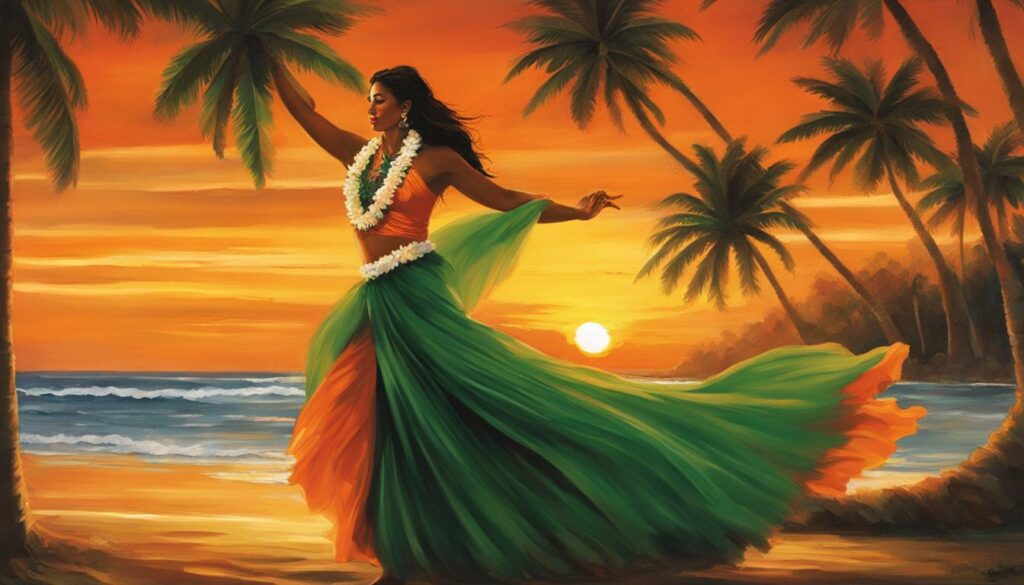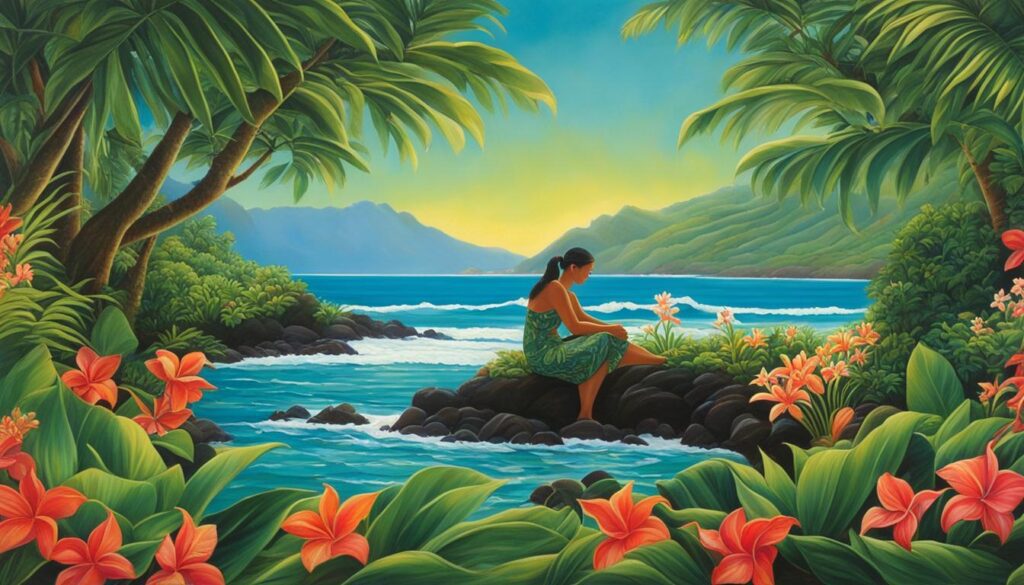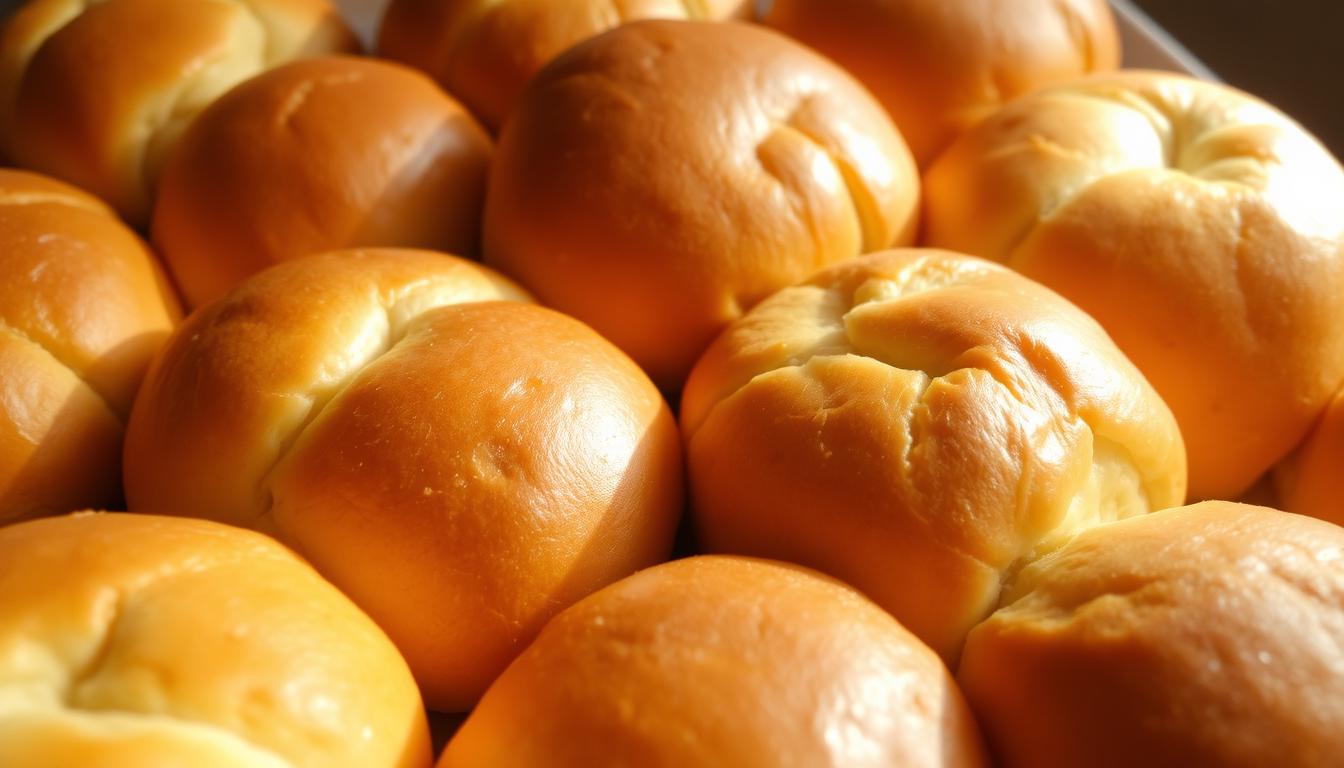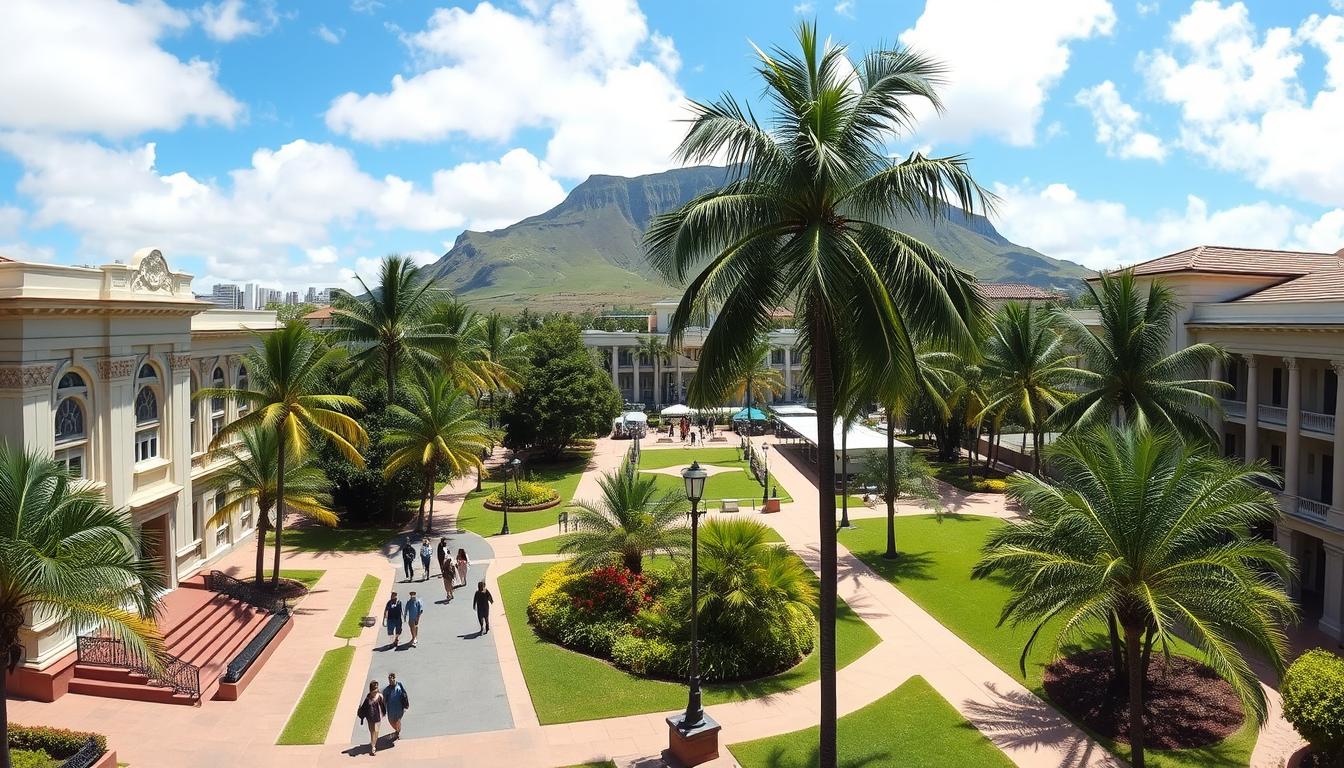Hawaii is known for its vibrant culture and rich traditions that are deeply rooted in the spirit of aloha. When it comes to celebrating the New Year, the Hawaiian people have their own unique customs that reflect their love for the land, connection to their community, and appreciation for their heritage. From heartfelt greetings to lively festivities, here are some of the traditional New Year celebrations in Hawaii that you won’t want to miss.
Key Takeaways:
- Hawaii celebrates the New Year with its own unique customs and traditions.
- Honoring the aloha spirit, the Hawaiian greeting “honi iku” involves touching noses.
- Lei-giving is a common practice in Hawaii, symbolizing love and celebration.
- Hula dance is a sacred form of storytelling in Hawaiian culture.
- The Hawaiian Luau is a feast and celebration filled with music, dancing, and traditional food.
Greetings and Exchanges: Honi Iku and Lei-giving
Hawaii is known for its warm and welcoming culture, where greetings and exchanges play an important role in establishing connections and fostering a sense of community. Two key aspects of Hawaiian greetings are the honi iku and lei-giving traditions, which embody the spirit of aloha.
Honi Iku: The Sacred Touch
Honi iku is a traditional Hawaiian greeting that involves the exchange of breath and the touching of noses. This intimate gesture symbolizes the sharing of life force, or “ha,” and is seen as a way of connecting on a deep spiritual level. Honi iku is a respectful and reverent greeting that represents the unity and harmony between individuals.
Lei-giving: A Symbol of Love and Celebration
Another iconic Hawaiian tradition is the giving of leis. Made from fresh flowers, leaves, or other materials, leis are presented with a warm embrace and a kiss on the cheek. They are given to honor, celebrate, or show love and respect. The act of presenting a lei is a heartfelt expression of the aloha spirit, representing the value of connection and unity among people.
The honi iku and lei-giving traditions are deeply rooted in Hawaiian culture and are practiced during various occasions, including special events, celebrations, and even everyday encounters. These customs serve as reminders of the importance of genuine human connections, respect for others, and the spirit of aloha that is at the heart of Hawaiian life.
| Honi Iku | Lei-giving |
|---|---|
| Symbolizes the exchange of breath and life force | Represents love, honor, and celebration |
| Based on touching noses | Involves presenting a lei with a warm embrace and a kiss on the cheek |
| Signifies unity and harmony | Expresses the aloha spirit and the value of connection |
Hula Dance: Sharing Stories through Movement
The hula dance is an integral part of Hawaiian culture, serving as a means of storytelling, cultural expression, and connection to the land. This ancient art form dates back to the Polynesian settlers who first arrived in Hawaii, and it has evolved over the centuries into a vibrant and distinctive dance style.
The Kahiko Style
In traditional hula, known as Kahiko, dancers evoke the spirit of the past through their movements and chants. The Kahiko style involves both vigorous and graceful movements, accompanied by rhythmic drumming and chanting. Each movement and gesture has a specific meaning, conveying stories of Hawaiian legends, history, and mythology.

Hula as Storytelling
Through hula, the dancers serve as the storytellers, sharing the history and traditions of the Hawaiian people. The graceful swaying of the hips represents the ebb and flow of the ocean, while hand movements and gestures depict elements of nature, such as plants, animals, and celestial bodies. Facial expressions and eye movements add depth and emotion to the storytelling, allowing the audience to connect with the narrative on a profound level.
Hawaiian Culture and Hula
Hula is not just a dance; it is a reflection of the values and beliefs of the Hawaiian people. It is a way of honoring and preserving their history, customs, and cultural heritage. Hula embodies the spirit of aloha, promoting love, respect, and harmony. It is a celebration of the land, the people, and the unique spirit of Hawaii.
So, if you ever have the opportunity to witness a hula performance, take a moment to appreciate the rich storytelling and cultural significance that it represents. Whether it’s the ancient Kahiko or the modern Hula ‘Auana style, the hula dance continues to captivate audiences and keep the spirit of Hawaiian culture alive.
Hawaiian Luau: A Feast and Celebration
The Hawaiian Luau is a beloved tradition that brings together friends and family for a joyous feast and celebration. This cultural event represents the spirit of aloha and showcases the rich culinary heritage of Hawaii. The Luau is a time of abundance and gratitude, where traditional Hawaiian foods are shared and enjoyed amidst music, dancing, and laughter.
The centerpiece of the Hawaiian Luau is the sumptuous feast, which features a wide array of traditional dishes. From kalua pig, cooked in an underground imu oven, to lomilomi salmon, a refreshing and flavorful salmon salad, each dish reflects the unique flavors of the islands. Other popular dishes include poi, a staple made from pounded taro root, and haupia, a creamy coconut dessert.
The Hawaiian Luau is not just about the food, however. It is a celebration of community, love, and the spirit of hospitality. Guests are welcomed with open arms and greeted with traditional Hawaiian music and hula performances. The atmosphere is filled with joy and camaraderie as everyone comes together to share in the festivities.
Hawaiian Luau Menu:
| Appetizers | Main Dishes | Side Dishes | Desserts |
|---|---|---|---|
| Poke | Kalua Pig | Poi | Haupia |
| Spam Musubi | Laulau | Lomi Lomi Salmon | Mochiko Chicken |
| Chicken Long Rice | Loco Moco | Macaroni Salad | Malasadas |
| Shrimp Cocktail | Teriyaki Beef | Sweet Potato | Pineapple Upside Down Cake |
Attending a Hawaiian Luau is an unforgettable experience that immerses you in the vibrant culture and traditions of Hawaii. From the delectable food to the warm hospitality, it is a celebration of life and community. Whether you’re a visitor or a local, the Hawaiian Luau is a must-attend event that will leave you with lasting memories of the spirit of aloha.
Malama Aina: Caring for the Land
In Hawaiian culture, Malama Aina is a deeply-rooted value that emphasizes the importance of environmental stewardship and sustainability. It encompasses a holistic approach to caring for the land, recognizing that the health of the environment is intricately connected to the well-being of the Hawaiian people.
Hawaiians have long understood the profound interdependence between themselves and the natural world around them. They recognize that the land provides sustenance, shelter, and spiritual nourishment, and it is their responsibility to preserve these precious resources for future generations. Through practices such as sustainable agriculture, responsible fishing, and conservation efforts, Hawaiians actively demonstrate their commitment to Malama Aina.
Malama Aina is not just about protecting the physical landscape; it also involves fostering a deep sense of respect and gratitude for the natural world. Hawaiians believe that every aspect of the environment, from the mountains to the sea, is sacred and deserving of reverence. This mindset promotes a harmonious coexistence between humans and nature, ensuring that both thrive in a symbiotic relationship.
Hawaiian Values and Environmental Stewardship:
- Aloha ‘aina: This concept encapsulates love and respect for the land. It encourages individuals to care for and nurture the environment as an expression of gratitude.
- Pono: Pono means to do what is right and just. It guides Hawaiians in making decisions that prioritize the long-term well-being of the land and its resources.
- Kuleana: Kuleana refers to personal responsibility. Hawaiians acknowledge their role as stewards of the land and take ownership of their duty to protect and preserve it.
| Hawaiian Values | Environmental Stewardship |
|---|---|
| Aloha ‘aina | Expressing love and respect for the land |
| Pono | Making decisions that prioritize the environment |
| Kuleana | Taking personal responsibility for caring for the land |
By upholding these Hawaiian values and practicing Malama Aina, Hawaiians ensure the preservation of their cultural heritage and the protection of their ancestral lands. It is a testament to their deep connection to the environment and their commitment to maintaining a sustainable and thriving ecosystem for generations to come.

Sharing Aloha: A Gesture of Love and Respect
In Hawaiian culture, the act of Sharing Aloha holds great significance. It goes beyond a simple greeting, encompassing love, respect, and kindness towards others. This genuine gesture of goodwill is deeply ingrained in the fabric of Hawaiian society and contributes to the strong sense of community and cohesion.
The Hawaiian greeting is a powerful expression of Aloha, which extends beyond words to encompass a warm and welcoming spirit. It is a way of acknowledging and honoring others, making everyone feel valued and appreciated. Whether it is a loved one, a friend, or a stranger, sharing Aloha creates a sense of connection and fosters positive interactions.
At the core, Aloha represents love and respect for all living beings and the world around us. It is an attitude of compassion, empathy, and understanding that promotes harmony and unity. By embracing the spirit of Aloha and Sharing Aloha with others, we can create a more compassionate and loving society.
The Cultural Significance of Sharing Aloha
Sharing Aloha is not just a superficial act; it is deeply rooted in Hawaiian culture and traditions. It reflects the core values of the Hawaiian people, emphasizing the importance of love, respect, and unity. By extending the spirit of Aloha to others, Hawaiians demonstrate their commitment to fostering meaningful connections and nurturing a sense of community.
Through Sharing Aloha, Hawaiians embody the essence of their culture, preserving and passing down a tradition that has shaped their way of life for generations. It serves as a reminder of the interconnectedness of all beings and the responsibility to treat others with kindness and compassion.
In conclusion, Sharing Aloha is more than just a greeting or a cultural practice; it is a profound gesture of love and respect. It represents the heart and soul of Hawaiian culture, promoting unity, compassion, and a sense of belonging. By embracing the spirit of Aloha and Sharing Aloha with others, we can cultivate a more harmonious and inclusive world.
Ohana and Community: The Importance of Connection
In Hawaiian culture, the concept of Ohana, meaning family, extends far beyond blood relatives. It encompasses close friends and anyone who becomes a part of one’s inner circle. Ohana plays a central role in Hawaiian society, emphasizing the importance of connection, support, and a sense of belonging. Building and maintaining an Ohana is vital for integrating into Hawaiian culture and fostering a strong community.
In Hawaiian communities, the spirit of Ohana is evident in the way people come together to help and support one another. Whether it’s organizing events, sharing resources, or offering a helping hand, the sense of community is deeply ingrained. This connectedness creates a strong support system that uplifts individuals and strengthens the bonds between neighbors, friends, and extended family.
Being a part of an Ohana in Hawaii means having a sense of responsibility and obligation towards one another. It involves showing respect, humility, and kindness in all interactions. The values of Ohana are passed down through generations, ensuring that the spirit of connection and community lives on.
Table: Ohana and Community in Hawaiian Culture
| Core Elements | Description |
|---|---|
| Sense of Belonging | The feeling of being connected to a community and having a place to call home. |
| Support System | The network of individuals who provide emotional, social, and practical support. |
| Shared Responsibilities | The understanding that everyone has a role to play in contributing to the community’s well-being. |
| Cultural Preservation | The passing down of cultural traditions and values through generations. |
Being a part of an Ohana and the larger Hawaiian community instills a deep sense of identity and pride. It fosters a strong connection to the land, culture, and heritage of Hawaii. Through the values of Ohana, Hawaiians create a harmonious and supportive environment where individuals can thrive and flourish.
The Art of Storytelling: Hula, Chants, and Oral History
Storytelling has long been an integral part of Hawaiian culture, passed down through generations. Through the art of hula, chants, and oral history, the rich heritage and traditions of the Hawaiian people come alive. These forms of communication and expression serve as a means of sharing knowledge, preserving cultural practices, and connecting with the past.
Hula, a sacred dance form, is not merely a performance but a storytelling medium. It involves intricate movements, gestures, and facial expressions that depict ancient legends, historical events, and the wonders of nature. Hula’s combination of dance, music, and storytelling captivates audiences and conveys the essence of Hawaiian culture.
In addition to hula, chants and oral history are essential components of Hawaiian storytelling. Chants, known as oli, are rhythmic recitations that use poetic language and melodies to convey narratives and invoke spiritual connection. Passed down orally, these chants provide insights into Hawaiian traditions, beliefs, and values. Meanwhile, oral history allows for the preservation of personal stories, family genealogies, and the collective memory of the Hawaiian people.
The Significance of Storytelling in Hawaiian Culture
Storytelling serves as a bridge between generations and a means of cultural preservation. It not only educates but also strengthens the sense of identity and pride within the Hawaiian community. Through the art of storytelling, the wisdom and legacy of ancestors are carried forward, ensuring that Hawaiian culture continues to thrive.
| Form of Storytelling | Description |
|---|---|
| Hula | A sacred dance form that incorporates storytelling through movement, music, and expression. |
| Chants (Oli) | Rhythmic recitations that use poetic language and melodies to convey narratives and invoke spiritual connection. |
| Oral History | The tradition of passing down personal stories, family genealogies, and collective memory through spoken word. |
Storytelling through hula, chants, and oral history is not limited to formal performances or cultural events. It is a living tradition that continues to evolve and adapt in contemporary Hawaiian society. By embracing these storytelling practices, Hawaiians honor their ancestors, cultivate a deeper connection to their roots, and celebrate the richness of their cultural heritage.
Cultural Fusion: Influences from Different Cultures
Hawaii’s unique cultural landscape is a result of the diverse influences brought by various cultures from around the world. The islands have been shaped by waves of immigration, with people from Asia, Europe, and the Americas bringing their customs, traditions, and languages to Hawaii. This cultural fusion has created a vibrant and multicultural society that is rich in diversity and offers a unique blend of customs and practices.
One of the most significant influences on Hawaii’s culture is the plantation era. Plantation workers from countries such as Japan, China, the Philippines, and Portugal arrived in Hawaii to work on sugarcane and pineapple plantations. These workers brought with them their own customs, food, music, and language, which have become integral parts of the local culture.
Influences from Asia
Asian cultures, particularly Japanese and Chinese, have played a significant role in shaping Hawaiian customs. Japanese traditions like Bon dance and the art of bonsai have become popular in Hawaii, while Chinese customs such as lion dancing and the celebration of Lunar New Year are widely observed. The fusion of Asian customs with Hawaiian traditions has resulted in unique festivals and events that showcase the diversity of Hawaii’s multicultural society.
Influences from Polynesia
Hawaii’s cultural heritage is deeply rooted in Polynesian traditions. The Polynesian voyagers who settled in Hawaii centuries ago brought with them their own language, music, and dance. The hula, a traditional Hawaiian dance, is believed to have originated from Polynesian influences. Today, hula is not only a celebration of Hawaiian culture but also a representation of the Polynesian heritage that is shared across the Pacific region.
Influences from Europe and the Americas
European and American influences can also be seen in Hawaii’s customs and practices. The introduction of Christianity by European missionaries has had a lasting impact on Hawaiian religious beliefs and practices. American traditions, such as Thanksgiving and Independence Day, are celebrated alongside Hawaiian festivals, creating a unique blend of cultural observances.
In conclusion
The cultural fusion in Hawaii is a testament to the island’s history of immigration and the blending of different customs. The multicultural society of Hawaii offers a rich tapestry of traditions, rituals, and celebrations that continue to thrive and evolve. It is this diversity that makes Hawaii a truly unique and welcoming place, where people from different cultures come together to create a vibrant and harmonious community.
Hawaii’s Unwritten Language: Pidgin and Local Slangs
In addition to the rich Hawaiian language, Hawaii also has its own unique vernacular known as Pidgin. Pidgin is a creole language that has evolved over the years, blending influences from Hawaiian, English, and various other languages spoken by different immigrant communities in Hawaii. It is a reflection of the diverse cultural heritage that has shaped the islands’ history and way of life.
Pidgin is characterized by its distinct pronunciation, grammar, and vocabulary. It incorporates words and phrases from different languages, resulting in a colorful and expressive way of speaking. Local slangs, such as “bruddah,” “ono,” and “da kine,” are commonly used in everyday conversations, adding a unique flavor to the language. Pidgin is an important part of the local identity, fostering a sense of community and connection among the people of Hawaii.
Hawaiian Pidgin Example Phrases
| Pidgin Phrase | English Translation |
|---|---|
| Wassup, brah? | What’s up, brother? |
| Grindz stay ono! | The food is delicious! |
| Howzit? | How are you? |
| Stay pau hana. | Work is done for the day. |
While Pidgin is widely understood and spoken in Hawaii, it is important to note that it may not be appropriate to use in formal or professional settings. It is primarily used in casual conversations among friends, family, and within the local community. Visitors to Hawaii may encounter Pidgin in everyday interactions, adding to the authentic cultural experience of the islands.
Hawaii’s Unique Customs and Lifestyle
Hawaii’s customs and lifestyle are deeply rooted in the values of respect and aloha. Hawaiians prioritize treating others with kindness, humility, and reverence, creating a harmonious and welcoming environment for all. From the moment you step foot in Hawaii, you’ll notice the emphasis on respect for both people and the natural world.
One key aspect of the Hawaiian lifestyle is the importance placed on community and interconnectedness. Hawaiians have a strong sense of Ohana, meaning family, which expands beyond blood relatives to include close friends and anyone who becomes part of one’s inner circle. Building and maintaining an Ohana is vital for integrating into Hawaiian culture and fostering a sense of belonging and support within the community.
Hawaiians also have a deep appreciation for the land and environment, as shown through the value of Malama Aina. Malama Aina emphasizes the responsibility of caring for the land and being good stewards of the resources that sustain the Hawaiian people. This commitment to environmental stewardship and sustainability is a fundamental way of life in Hawaii.
In addition to their customs, Hawaiians prioritize character and relationships over material possessions. They value genuine connections and experiences over material wealth, emphasizing the importance of love, friendship, and meaningful interactions. This focus on intangible values creates a lifestyle centered on gratitude, humility, and the true essence of aloha.
FAQ
What are some traditional New Year celebrations in Hawaii?
Hawaii celebrates New Year with various customs and traditions that showcase the rich culture of the Hawaiian people.
What is the significance of honi iku and lei-giving in Hawaiian culture?
Honi iku, the traditional Hawaiian greeting, involves touching noses and symbolizes the exchange of the breath of life. Lei-giving, on the other hand, is a common practice in Hawaii and involves giving fresh flower and leaf necklaces to honor, love, and celebrate special occasions.
How does hula dance tell stories and share Hawaiian traditions?
Hula is a sacred dance in Hawaiian culture that was traditionally used to share stories, traditions, and mythology. Ancient hula, known as Kahiko, involves chanting and expressive movements that convey a narrative.
What is the Hawaiian Luau and what does it represent?
The Hawaiian Luau is a traditional gathering where friends and family come together to enjoy a feast of traditional Hawaiian food. It represents a time of celebration, music, dancing, and the sharing of delicious local cuisine.
What is the importance of Malama Aina in Hawaiian culture?
Malama Aina is a core Hawaiian value that emphasizes the importance of caring for the land and the environment. It represents being responsible stewards of the resources that sustain the Hawaiian people.
What is the significance of Sharing Aloha in Hawaiian culture?
Sharing Aloha is a gesture of giving one’s time, attention, and care to others. It embodies the act of showing love, respect, and kindness to both loved ones and strangers, contributing to the sense of community and cohesion in Hawaiian culture.
What is Ohana and why is it important in Hawaiian culture?
Ohana, meaning family, plays a central role in Hawaiian culture. It extends beyond blood relatives to include close friends and anyone who becomes a part of one’s inner circle. Building and maintaining an Ohana is vital for integrating into Hawaiian culture and fostering a sense of belonging and support within the community.
How does storytelling contribute to Hawaiian culture?
Storytelling has long been an integral part of Hawaiian culture, passed down through generations through hula, chants, and oral history. It serves as a means of sharing knowledge, traditions, and the rich heritage of the Hawaiian people.
How has the blending of different cultures influenced Hawaii’s customs and lifestyle?
Hawaii’s unique cultural landscape is influenced by various cultures brought by plantation workers, contributing to the diversity and fusion of traditions on the islands. The blending of different customs has shaped the contemporary Hawaiian lifestyle and celebrations, creating a vibrant and multicultural society.
What is Pidgin and how does it reflect the local culture in Hawaii?
Pidgin is a mixed English dialect that has evolved into a unique language reflecting the local culture and way of life in Hawaii. It is characterized by simple phrases, humor, and local slangs, and while it may be fun to explore, it is important to use Pidgin with caution and respect.
What values are central to Hawaii’s customs and lifestyle?
Hawaii’s customs and lifestyle are centered around respect, humility, and a deep appreciation for the land and environment. From taking off shoes when entering a home to valuing character over material possessions, Hawaiians prioritize the interconnectedness of people, culture, and nature, fostering a sense of harmony, positivity, and aloha.

Scott Sweeney is the creator of Virtual Hawaii 360. Scott is a professional marketer and a lifelong Hawaii enthusiast. Scott splits time between Oahu and Dayton, Ohio. In addition to his marketing endevours, he is also a published Ukulele musician.





